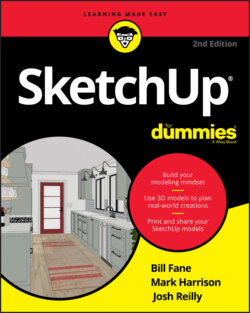Читать книгу SketchUp For Dummies - Mark Harrison - Страница 45
Linear inferences
ОглавлениеAs you’ve probably already noticed, color plays a big part in SketchUp’s user interface, or the way it looks. Maybe the best example is in the software’s linear inferences — the “helper lines” that show up to help you work more precisely. Figure 3-13 illustrates the important linear inferences, and here’s a description of what they do:
On Axis: When an edge you’re drawing is parallel to one of the colored drawing axes, the edge turns the color of that axis. In Figure 3-13, you see the On Red Axis inference.
From Point: This one’s a little harder to describe. When a colored dotted line appears as you move your cursor, your cursor is “lined up” with the point at the other end of the dotted line. Naturally, the color of the From Point inference reflects the axis you’re lined up “on.” Sometimes, From Point inferences show up on their own, and sometimes you have to encourage them; see the section “Using inferences to help you model” later in this chapter for details.
Perpendicular: When you draw an edge that’s perpendicular to another edge, the one you’re drawing turns magenta (reddish purple) unless it’s perpendicular to the red, green, or blue axes.
Parallel: When the edge you’re drawing is parallel to another edge in your model, it turns magenta to let you know. You tell SketchUp which edge you’re interested in “being parallel to” by encouraging an inference. You can try this out by hovering over one edge and then starting to draw another with the Line tool.
Tangent at Vertex: This one applies only when you draw an arc (using the Arc tool) that starts at the endpoint of another arc or an edge. When the arc you’re drawing is tangent to the other object, the one you’re drawing turns cyan. Tangent, in this case, means that the transition between the two arcs is smooth.
FIGURE 3-13: SketchUp’s linear inferences help you align new geometry with existing geometry.
One of the most important inferences in SketchUp is one that you probably didn’t even realize was an inference: Unless you specifically start on an edge or a face in your model, you always draw on the ground plane by default. That’s right — if you just start creating stuff in the middle of nowhere, SketchUp just assumes that you mean to draw on the ground.
